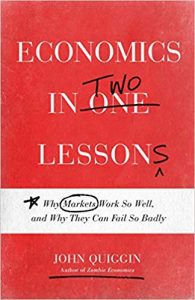John Quiggin has a mission to correct the perception that economics implies markets are always marvellous and government intervention terrible. The title of his new book, Economics in Two Lessons, riffs on a comment by Paul Samuelson about a 1946 bestseller called ‘Economics in One Lesson‘: “When someone preaches ‘Economics in one lesson,’ I advise: Go back for the second lesson.”Apparently, Economics in One Lesson by Henry Hazlitt, a ‘free market’ advocate has sold over a million copies and been continuously in print – who knew? I’ve never read it. Quiggin’s response in Economics in Two Lessons is an attempt to battle the perpetual appeal of simple answers to complex problems.
Economics in Two Lessons: why markets work so well and why they can fail so badly is essentially all about the many ways in which markets can fail. The books starts with Lesson One: the concepts of opportunity cost, gains from exchange and equilibrium, then introduces complexities: time, information (lack of) and uncertainty. Some nice applications follow, such as price controls, ‘free’ goods, spectrum auctions, road pricing. Quiggin uses the concept of opportunity cost as a frame for the remainder of the book, including when market prices diverge from opportunity cost.
“Most of the questions of principle involved in public policy can be illuminated by the careful application of the idea of oportunity cost and its relationship to market prices.” Lesson One is that market prices reflect and determine opportunity costs in production and consumption. Lesson Two is that there are social opportunity costs to be taken into account as well.
Hence the book then moves on to the ‘second lesson’, turning to income distribution, unemployment, natural monopolies, externalities like pollution and financial bubbles. The final section turns to policy prescriptions for a market failure world. For example, a chapter on income distribution looks at unions, minimum wages, and issues relating to income ‘predistribution’ such as intellectual property and limited liability.
There are plenty of examples and the book is very clear, making it an attractive supplement for undergraduate courses – I guess this is the target market as each chapter has further reading. I like the way Quiggin weaves in the history of economic thought on these issues. It’s a shame he feels the need to knock ‘mainstream’ economics so much; there’s little here for a mainstreamer to disagree with, except swipes like these: “The term ‘externality’ is one of those bits of jargon that most economists would be at a loss to explain.” What a bizarre claim. I have other quibbles – for instance, I’d disagree that Mill-ian utilitarianism is inherently more egalitarian than post-Pareto welfare economics.
On the whole, though, this is a highly readable introduction to the intellectual framework of modern policy economics, with plenty of lively examples (although I hope that those teaching public policy economics will also consider my forthcoming – late 2019/early 2020 – Markets, States, People……). It doesn’t dethrone my favourite book to recommend to newcomers to economics, John McMillan’s Reinventing the Bazaar either, but is well worth reading. Just remember – this isn’t anti-mainstream economics, it’s what economics is.
[easyazon_link identifier=”0691154945″ locale=”UK” tag=”enlighteconom-21″]Economics in Two Lessons[/easyazon_link]

